It’s unusual for me to even see these two species much less get decent photos of them.
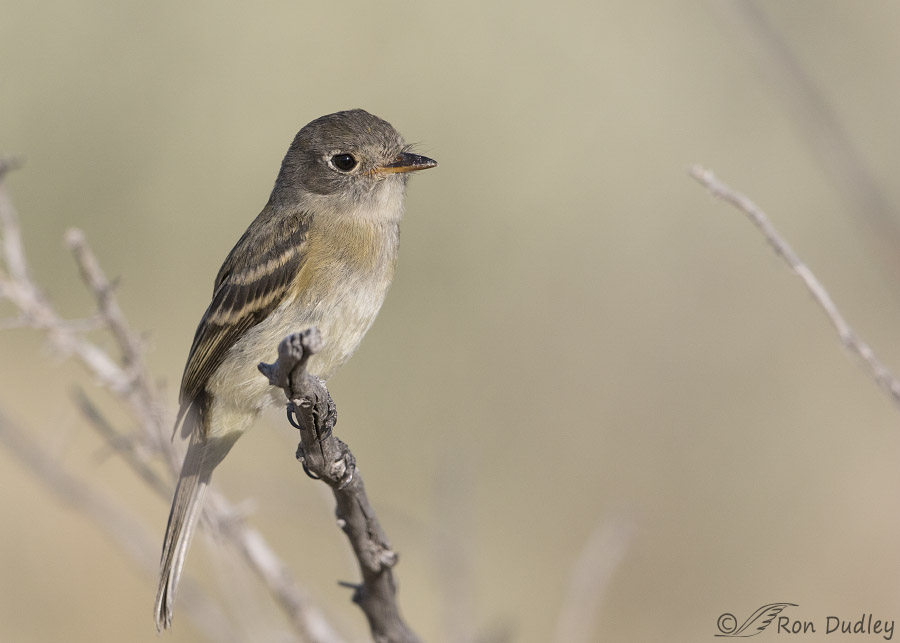
1/4000, f/6.3, ISO 640, Canon 7D Mark II, Canon EF 500mm f/4L IS II USM + EF 1.4 III Extender, not baited, set up or called in
I photographed this Willow Flycatcher eleven days ago while I was working hummingbirds as they fed on bee plant nectar. The bird suddenly appeared close to me in order to hunt insects around the bee plant and some adjacent dead sagebrush. I was disappointed that there was a very out of focus twig in front of its tail but I photograph this species so seldom I was still happy to get the shot.
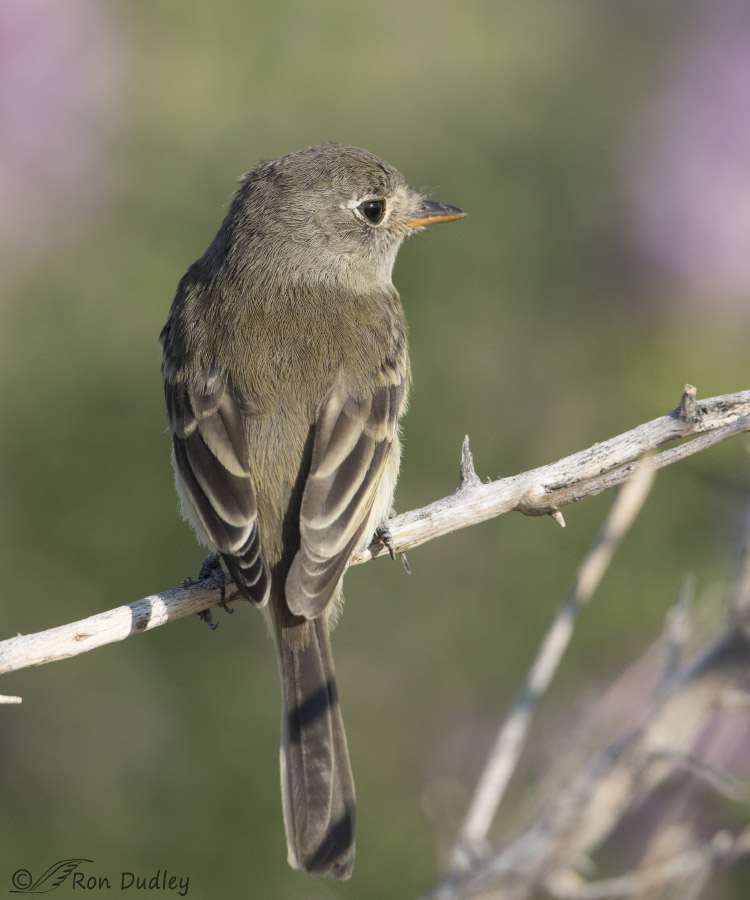
1/2000, f/6.3, ISO 640, Canon 7D Mark II, Canon EF 500mm f/4L IS II USM + EF 1.4 III Extender, not baited, set up or called in
The same bird came in even closer but it had its back to me and never did give me a compensating head turn.
So each photo is seriously flawed but in all the years I’ve been blogging I’ve only posted images of this species once so I couldn’t resist including these today. I like just seeing the bird up close and I hope others do too.
Yesterday morning I spent several hours in canyons of the Wasatch Mountains looking for birds and was mostly skunked. By the time I was almost ready to head home I had no decent images to show for my time and effort but there had been one bright spot- several bugling elk! I didn’t see them but I heard at least two of them clearly for several minutes as that unique and haunting sound came echoing down a smaller side canyon in the still of the morning. It seemed just a little early in the season but apparently the rut is about to begin. These are exciting times for elk and for anyone lucky enough to hear and/or see them.
So I headed down the canyon thinking the bugling elk would likely be my only memorable nature experience of the morning but an unexpectedly cooperative Gray Catbird proved me wrong.
1/1600, f/6.3, ISO 500, Canon 7D Mark II, Canon EF 500mm f/4L IS II USM + EF 1.4 III Extender, not baited, set up or called in
All morning every likely place I stopped to look for birds was devoid of them but I stopped once more and after a while this catbird flew into a tree right in front of my lens (I had no inkling it was even in the vicinity). This photo was taken only a second or two after it landed and based on this pose it looks like it was about to take off again. Thankfully it didn’t and I was able to get 137 shots of it over several minutes.
Here we get a fairly good look at those rufous undertail coverts that are so often difficult to see. Sexes are indistinguishable so I don’t know if this is a male or female.
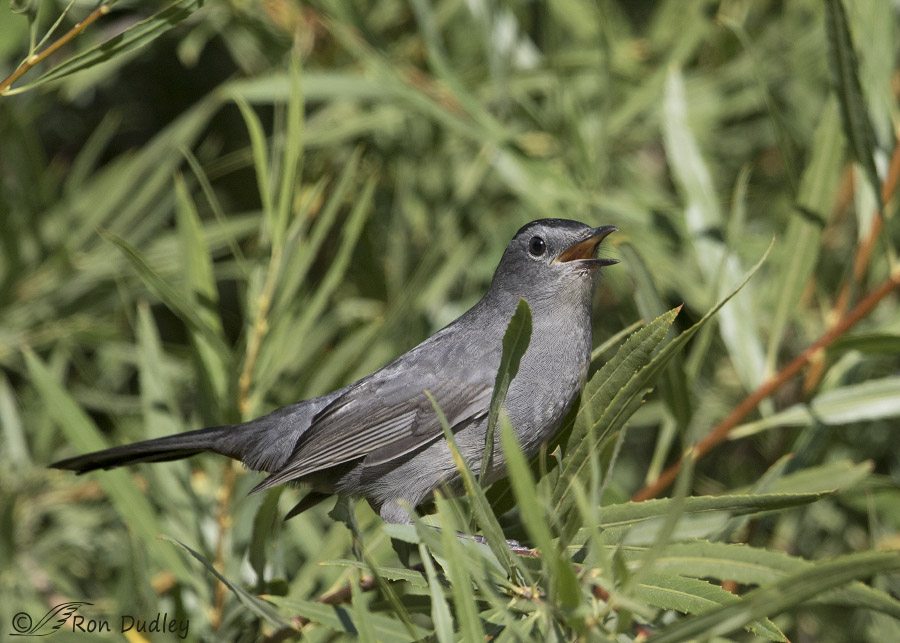
1/1600, f/6.3, ISO 500, Canon 7D Mark II, Canon EF 500mm f/4L IS II USM + EF 1.4 III Extender, not baited, set up or called in
This may or not be a calling pose – if it was calling I don’t remember hearing it but that sometimes happens when I’m so involved with the photography task at hand. Like other Mimids catbirds display considerable vocal versatility and part of that ability is due to the unusual structure of their syrinx (the specialized voice organ of birds). In catbirds both sides of the syrinx can operate independently so they can sing or call with two voices at the same time.
How’s that for a nifty trick!
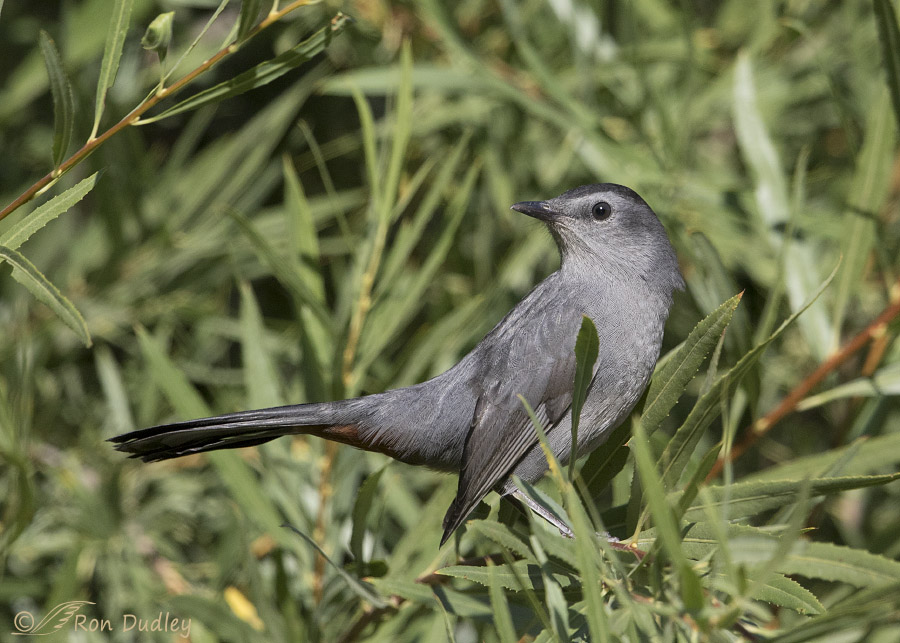
1/3200, f/6.3, ISO 800, Canon 7D Mark II, Canon EF 500mm f/4L IS II USM + EF 1.4 III Extender, not baited, set up or called in
In the time I spent with it the bird didn’t give me much pose variety and I missed the takeoff (though I came very close to getting it) but one time it did look to its rear. This is one of the better views I got of that distinctive blackish cap.
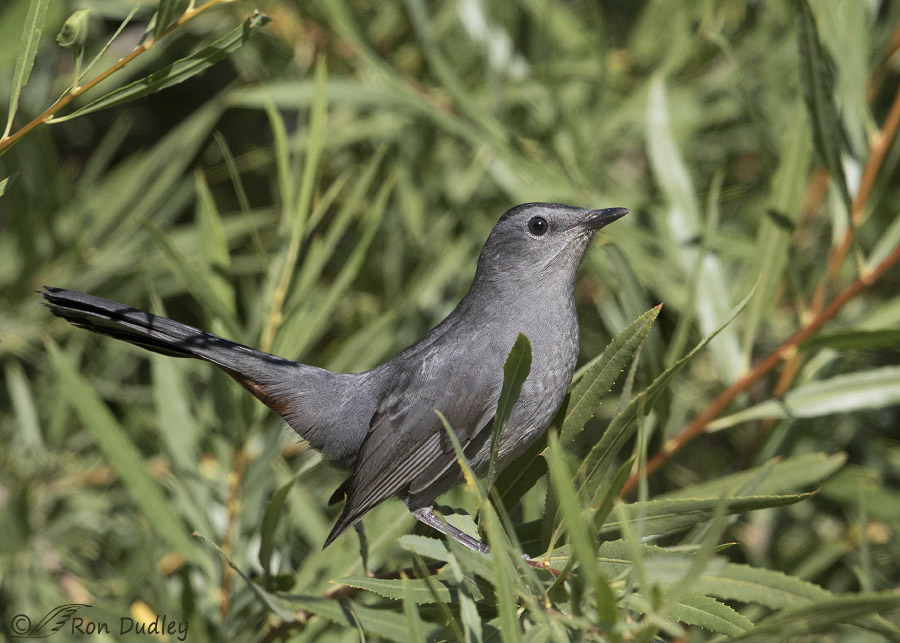
1/1600, f/6.3, ISO 500, Canon 7D Mark II, Canon EF 500mm f/4L IS II USM + EF 1.4 III Extender, not baited, set up or called in
Despite the shadows on the tail this might be my favorite pose because I like that perky but droopy-winged look.
I was excited to get these shots – partly because I’ve been trying to get nice catbird photos for many years and they’ve always eluded me (here in Utah we’re right on the edge of their range). Yes, the setting is busy and there’s “stuff” in front of the bird but this is typical habitat for the species so I like that congruity.
After all, their genus name, Dumetella, means “small thicket” which reflects their preferred habitat – dense, shrubby vegetation, so as far as I’m concerned this setting works just fine. But then I’m the photographer so I may be biased…
Ron


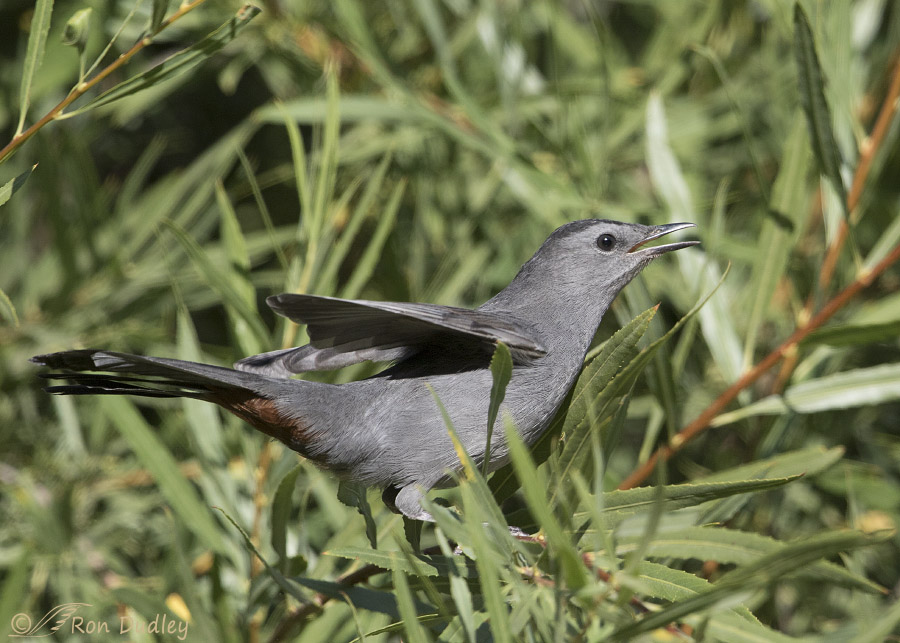

Ron,
My wife and I discovered the cat birds a few years ago in a forrest in in Omaha. We have lots that come to our backyard but they seem to have left now.
I have a technical question for you. How do you learn to track the birds so well in fright and get such sharp images?
I am trying ti get better but so hard I guess I need to learn more about the specific birds behaviors.
Any suggestions?
Is it possible that this is a fledgling calling for food but it’s too old for the parents to come? The raised and drooped wing postures remind me of the movements made when they are begging. No confusing jumble of familiar calls struck your ear? The older ones seem to always be singing or regarding me with alarm and making their catcall.
We are abounding with Catbirds here, aplenty. But so glad you included info on those complex sounds they make. I will remember this post everytime i hear them, which is often here in se pa.
“Abounding with catbirds” would be a good thing, Fran. I’m jealous. I was looking for them again this morning – found a few but none of them cooperated.
Two stunning little birds. As others have said before me, anyone who dismisses the little brown (or grey) jobs really needs to open their eyes (and minds). The colours are often intricate, delicate and a joy.
You’ve been beating that drum (for LBJ’s in particular) for a very long time, EC. And you’re right of course…
You certainly ended up in the catbird’s seat! (Sorry. It was just too good an “oppuntunity” to pass up.)
I agree with Laura — if anyone thinks grey (or brown) is boring, they have not seen your blog! I especially am drawn to the second flycatcher shot because of the patterns made by the bird’s primaries. I also really like the catbird looking over its shoulder; makes me wonder what’s back there, which pulls me into the photo even more.
Oh yes, brown is spectacular, too! In sunlight, a redtail’s brown contains violet hues. VIOLET? Who’da thunk THAT?! I mean really, VIOLET? Also in the sunlight, a Harris’ hawk’s brown feathers show oranges and red hues! Just WOW!
Birds, the whole darn lot of ’em, are just spectacular in their beauty and grace, well, except for those times that majestic is just not working for ’em. That happens to all of us. LOL!
Thank you, Marty.
I’ve never seen a Willow Flycatcher, so it’s nice to see photos. I always enjoy watching Catbirds when we’re at the beach in NC, where there are lots of them. I will never forget the one time I heard one sound like a cat – out in the middle of a marsh on the north end of Assateague Island (off the coast of Maryland). It sounded like a cat that wanted breakfast yesterday, which had me confused until I was finally able to figure out what I was hearing. Fun memory! I think I like the last shot of the Catbird best, although they are all good.
Susan, sometimes they sound remarkably like a cat but much of the time you’d never make that connection because their calls can be so different.
Beautiful shots, Ron! Such a treat to see these birds up close through photographs – the light and feather quality are fantastic. Thanks for the information about the two-voiced catbirds – neat!
Thank you, Myriam.
Nice, thank you Ron! Looked the Catbird up and it is a bird of this area. Read about how it tosses Cowbird eggs from nests. Then checked out the Cowbirds and noticed how they lay eggs in other species nests so other species can raise the young. Lazy Cowbirds-smart Catbirds.
Another thing about their relationship with cowbirds, Shirley – as you mentioned they dispose of cowbird eggs laid in their nests. But it amazes me that that behavior has to be learned by each new generation. It’s isn’t instinctual.
What a splendid series! Who says gray is a monochromatic color? If you can believe that, you haven’t been watching birds because they have a quality of gray, an intricate weaving of different shades and textures that skip and play along the whole range of color. Gads I love birds! What sheer delight they bring!
Gray catbirds used to scold the Cornell hawk nest chatters when we’d gather in front of the Plant Sciences Building, just across the street from the redtail hawk nest. There would be dozens of them in the thick shrubbery that bordered Mim’s Garden. When I had a chance to sit down and relax for a few minutes, I’d talk with them for a while and just enjoy their flitting presence.
And what a treat to hear the rutting elk! When I lived in Wyoming, I got to hear them several times, but only saw them once. Oh how beautiful!
I’m also delighted that my JRT resumed her alarm clock activities. She wakes me between 5:25 and 5:35 every morning so that I get to watch the glorious sunrises, looking east for the light play of dawn and then looking west to watch the colors of the dawn play along the mountains, painting with color and shadow! Granted that we don’t have another planet for comparison, but this Earth is quite the magically glorious home.
“Who says gray is a monochromatic color”
Or as someone else on FB said, “Who says gray can’t be beautiful?”. Thanks, Laura.
WOW! These are great shots Ron, Congratulations!!
The Catbird images are so typical of this species, they are spot on!
Thanks for sharing.
Thanks very much, Dick.
Outstanding Ron!
Charlotte
Thanks, Charlotte.
The catbird shots are beautiful, Ron. They have a subtle beauty to them. The voice set up for calls sounds like they can “talk out of both sides of their mouth” Even if the Willow Flycatcher isn’t perfect you “got it” so a productive morning. Did you ever catch up with the Elk? Does seem a bit early for them to be bugling – it is a haunting sound.
Even if the Willow Flycatcher isn’t perfect you “got it” so a productive morning. Did you ever catch up with the Elk? Does seem a bit early for them to be bugling – it is a haunting sound.
“The voice set up for calls sounds like they can “talk out of both sides of their mouth”
Yup, I came very close to making a very appropriate comparison to a certain politician in my text but I resisted…
No, I never did see the elk. I scanned the mountainside with my lens but came up empty. They must have been hidden in the trees.
Ron. The flycatcher is perfect as is. The twig is no problem and wild birds won’t always be able to pose perfectly.
Thanks for the biology of the catbird syrinx. Looks like it is calling to my eye. Many thanks for starting my day.
It certainly could have been calling, Diana. I’d been hearing them off and on all morning but I was concentrating so much on getting the photos I didn’t notice if I could hear its call or not. Sometimes I have difficulties with that walking and chewing gum at the same time thing…